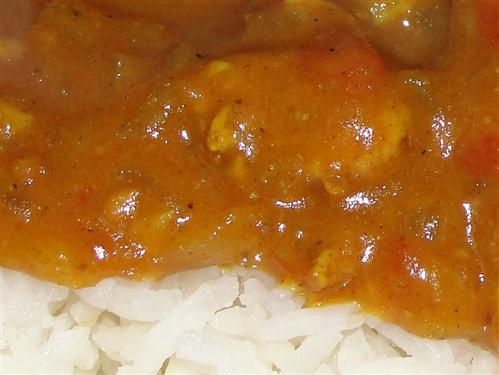The Tale of a (not) Indian Princess
 Friday, April 8, 2011 at 12:58AM |
Friday, April 8, 2011 at 12:58AM |  Taneasha
Taneasha 
Looks pretty good, doesn’t it? Well, let me tell you the tale of my attempt at creating an Indian like dish.
Once upon a time, there was a young princess named Taneasha (Just go with it. It’s my story, I can tell it how I want). Although she had a name that was foreign, odd, or at the very least not befitting her, it was certainly not Indian. In spite of that, and the fact that she was far too lazy to put in the effort to do it properly, she decided to try her hand at preparing a fabulous Indian delight. With merely the intention of creating a dish that resembled the flavors and structure of Indian cuisine, she gathered her ingredients and set to work.
1 boneless, skinless chicken breast
1 medium onion
½ inch piece of ginger
4-5 garlic cloves
1 cup diced tomatoes with juice
½ cup coconut milk
½ water
¼ teaspoon salt
2 Tablespoons vegetable oil
1 teaspoon garam masala
1 teaspoon coriander
1 teaspoon turmeric
1 teaspoon cumin
1 teaspoon paprika
¼ cup water (additional)
1 Tablespoon flour
First, she cut the chicken into bite sized cubes and set it aside. Next came the chopping. She peeled the ginger and garlic cloves and minced them as fine as a mere knife would allow.
Next came the onion, but not quite as fine.
While the oil was heating in a pan over medium heat, she measured all the spices (garam masala, coriander, turmeric, cumin, and paprika) into a small dish and stirred them together.
Then, into the pan went the onion, and the salt was sprinkled over the top.
After about a minute or two of stirring it around, the garlic and ginger were added. She continued to stir them about in the pan until the onion was nice and soft and translucent, about 5 – 7 minutes, before sprinkling the spice mixture over the top.
She knew the spices shouldn’t be exposed to the heat for very long before having liquid added, so she quickly mixed them into the onions and added the chicken.
After a mere 30 seconds, she poured in the tomatoes and water.
Of course, Taneasha’s servants always bottled tomatoes from the palace gardens while they were in season, but commoners could probably make do with store bought if necessary.
She placed a lid over the chicken mixture and allowed it to simmer for 15 minutes. This was good, because she was far overdue for some lemonade and a foot rub. The servants did, of course, stir it every few minutes to keep it from burning.
Refreshed and relaxed, she returned to the stove and poured in the coconut milk.
To her delight as she stirred it in, it was starting to resemble Indian dishes that had been prepared for her before.
To thicken things up just a bit, she mixed together the flour and water, and stirred them into the pan. When the mixture was thick and smelled fabulous, she spooned it over rice and added a piece of freshly baked naan. (Remember our pitas? I told you frozen ones would come in handy)
Proud of her accomplishment, Taneasha dished a plate for her prince and watched, eagerly awaiting his response as he took his first bite. To her dismay, it was not a look of delight, but of repulsion. As it turned out, the prince detested coriander. Even the princess was somewhat disappointed in the results. Although it didn’t taste bad, it could have used some more complex flavors. At the very least a tablespoon of honey or sugar, and even better would have been some mango puree and/or red bell pepper.
Perhaps princesses should leave the cooking to professionals, or at least stick to something more in their league.
In all seriousness, I had a meal made with one of these simmering sauces from a jar last week. It took maybe 20 minutes to prepare and was fabulous. Much better than this two hour investment in disappointment. Lesson learned.
